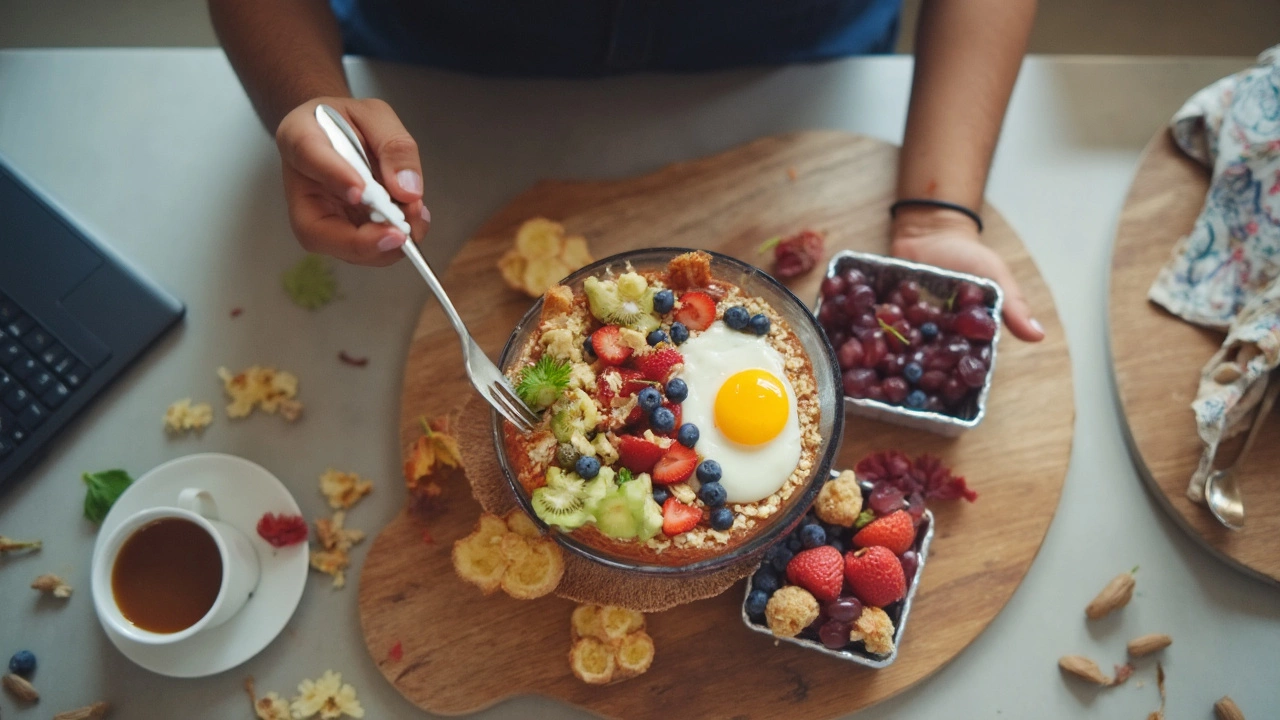Trying to eat healthy in the morning can feel like a juggling act, especially when you’re in a hurry. But what exactly counts as a “healthy breakfast”—and does one country actually do it better than the rest? While everyone loves a big, tasty plate, it’s really about balancing nutrition and speed.
Let’s get practical for a second. A healthy breakfast should fill you up (without a sugar crash), be easy to make, and tick the boxes for protein, healthy carbs, and good fats. But depending on where you live, breakfast looks wildly different. In India, you could grab a steaming idli with sambar or a bowl of poha in ten minutes flat, while in Japan, breakfast might mean grilled fish and miso soup—not exactly quick, right?
If you’re constantly on the lookout for quick breakfast ideas that don’t spoil your health goals, looking at what works in other countries can help. Some traditions are built for busy mornings—you just need to know the tricks.
- What Healthy Breakfast Means (and Why It Matters)
- Quick Indian Breakfast Staples: Nutritious and Fast
- How Other Countries Fuel Up: A Bite Around the Globe
- What Science Says—Are Some Breakfasts Healthier Than Others?
- Smart Tips for an Easy, Healthy Start
What Healthy Breakfast Means (and Why It Matters)
Let’s get real—skipping breakfast can mess up your energy, focus, and even your mood. There’s enough solid research showing that people who eat a balanced breakfast not only feel better in the morning, but also have an easier time managing their weight and blood sugar.
But what actually counts as a “healthy breakfast”? It’s not about fancy ingredients or Insta-worthy meals. The best breakfasts give your body a kickstart with a mix of:
- Protein (for staying full and building muscle, think eggs or dal)
- Good carbs (like oats or whole wheat—these keep your blood sugar steady)
- Healthy fats (you’ll find these in nuts, seeds, or a drizzle of ghee)
- Fruits or veggies (for vitamins, fiber, and more staying power)
If you load up on just toast and jam, you’ll be starving and cranky an hour later. But if you build in some protein and fiber, you're set till lunch—plus, your energy levels won’t crash. One study from the University of Bath found that eating a high-protein breakfast helped people eat less throughout the day compared to carb-only breakfasts.
The real trick? Keeping it practical. Here’s a super simple comparison of what a “healthy breakfast” might look like in practical terms:
| Breakfast Type | Protein (g) | Fiber (g) | Sugar (g) |
|---|---|---|---|
| Idli + Sambar (Indian) | 9 | 4 | 2 |
| Jam Toast | 2 | 1 | 7 |
| Egg & Veg Sandwich | 12 | 3 | 3 |
| Oats with Fruits | 6 | 5 | 5 |
See the difference? Packing protein and fiber really keeps you going and helps avoid the mid-morning slump. And when people talk about the healthiest breakfast, they’re usually talking about meals that nail that balance—no matter what country it’s from.
Quick Indian Breakfast Staples: Nutritious and Fast
If you think Indian breakfasts take too long, you’re missing out on some seriously quick and healthy options. They’re not just filling—they pack in real nutrients without much fuss. The best part? Most of these can be made in less than 20 minutes, perfect for busy mornings.
Quick breakfast India favorites usually hit that sweet spot between taste and health. You’ll see a lot of whole grains, lentils, and veggies in the classics. Here are a few that tick all the boxes:
- Poha: Flattened rice tossed with onions, peas, peanuts, turmeric, and a squeeze of lemon. Poha is super light, but the fiber keeps you full—plus, you barely need 15 minutes to whip it up.
- Upma: Made from roasted semolina, it gets its flavor from curry leaves, mustard seeds, and mixed veggies. Upma gives a decent balance of carbs and a bit of protein.
- Idli: These fluffy steamed rice cakes are paired with protein-rich sambar or coconut chutney. You can batch-make batter ahead of time, so all you need in the morning is a quick steam.
- Besan Chilla: Think of this as an Indian omelette—made with chickpea flour, onions, tomatoes, and spices. It cooks fast and has good protein, making it extra filling for little effort.
If you’re aiming for healthier swaps, try these tips:
- Add extra veggies to your poha or upma for more vitamins.
- Use less oil by sticking to nonstick pans or roasting instead of deep-frying.
- Prep batters or chop veggies the night before to save time.
Dietitians in cities like Mumbai and Bengaluru often recommend these dishes because they keep your energy steady and avoid sudden sugar spikes. And here’s the thing: you don’t give up flavor for health with these breakfasts, which makes sticking to good habits a lot easier.

How Other Countries Fuel Up: A Bite Around the Globe
If you peek into kitchens across the world at breakfast, you’ll spot all kinds of plates loaded in totally different ways. What counts as a morning meal in France isn’t close to what you’d get in Japan—or, for that matter, what’s typical in India. Let’s break down some common breakfast routines and see what makes them work, especially if quick and healthy is your vibe.
Japan sticks out for its simple, pure flavors and nutrient punch. A basic breakfast often features steamed rice, miso soup, grilled salmon or mackerel, and pickled veggies. It’s light on sugar and packed with protein and omega-3s. In fact, a 2019 study from Japan’s National Nutrition Survey found that people who ate traditional Japanese breakfasts had lower risks of obesity and heart disease.
Switch scenes to the Mediterranean, and you’ll see a different approach. In Greece, breakfast is usually yogurt with fresh fruit, honey, and nuts—quick to build, but keeps you full for hours. High in protein and probiotics, Greek yogurt has become a favorite worldwide for people looking for healthy and easy options. And let’s not forget Spain, where toast with tomato (pan con tomate) and olive oil is popular—simple, full of healthy fats, and convenient.
Take a look at Scandinavia: Swedes and Norwegians love rye bread, boiled eggs, and smoked fish or cheese. Lots of fiber and protein, but low in added sugar. Germany brings their own twist with whole grain breads, deli meats, and cheeses. Quick to put together, and all about balance.
Here’s a handy comparison showing typical breakfasts and their nutritional highlights:
| Country | Common Breakfast | Key Nutrition Features | Estimated Prep Time |
|---|---|---|---|
| Japan | Miso soup, rice, grilled fish, pickles | High protein, low sugar, omega-3s | 15–20 min |
| Greece | Greek yogurt, fruit, honey, nuts | Protein, probiotics, healthy carbs | 5–10 min |
| Spain | Pan con tomate, olive oil | Healthy fats, vitamins, fast to make | 5 min |
| Scandinavia | Rye bread, eggs, smoked fish/cheese | Fiber, protein, low sugar | 10–15 min |
| India | Idli, sambar, poha, upma | Balanced carbs, plant protein, spices | 10–20 min (less with prep) |
The truth is, there’s no one-size-fits-all healthiest breakfast worldwide. Different cultures find their own balance of carbs, protein, and fat, many of which are easy and quick to make. The key is finding what fits your lifestyle and makes you feel good. If a healthiest breakfast means no sugar crash and no hour-long prep, you’ve got plenty of great ideas to borrow from these countries.
What Science Says—Are Some Breakfasts Healthier Than Others?
If you ask nutrition experts, not all breakfasts are made equal. The healthiest ones hit three main things: steady energy, good balance of nutrients, and keeping you full till your next meal. Skipping breakfast can mess with your blood sugar and might even lead to unhealthy snack attacks later in the day.
The key? A mix of carbs, protein, and healthy fats—not just a boost from caffeine or sugar. Let’s get specific: whole grains (like oats or brown rice), lean protein (think eggs or yogurt), veggies, and fruit all stack the odds for lasting energy and better focus at work or school.
Here’s a quick side-by-side look at common breakfast styles around the world, and how they stack up for nutrition:
| Country | Typical Breakfast | Key Nutrition |
|---|---|---|
| India | Upma, Poha, Idli-Sambar | Complex carbs, some protein, low fat, fibre |
| Japan | Rice, fish, miso soup, pickles | Lean protein, fibre, minimal sugar, omega-3s |
| USA | Sugar cereal, toast, eggs, pancakes | High sugar (cereal/pancakes), or protein (eggs), variable fibre |
| France | Croissants, jam, coffee | Refined carbs, low protein, low fibre |
| Iceland | Skyr (strained yogurt), berries, rye bread | High protein, probiotics, complex carbs, fibre |
Studies show that breakfasts full of simple sugars (like white bread or pastries) may lead to tiredness and hunger faster than those packed with protein and fibre. For example, a research group in the UK found that people who ate eggs or high-protein yogurt in the morning reported feeling full for much longer compared to those who ate toast or cereal.
If you’re serious about having the healthiest breakfast, science says: go for fibre, protein, and healthy fats. You don’t need fancy ingredients. Even something as classic as poha tossed with veggies, or rolled oats with nuts and fruit, covers the basics. Skip sugar-heavy stuff—your body (and brain) will thank you later in the day.

Smart Tips for an Easy, Healthy Start
If mornings are chaotic, a few simple tweaks can turn breakfast into your healthiest habit, even if you’ve only got ten minutes. Let’s get down to the details—this isn’t about picture-perfect smoothie bowls, but about ideas that work, no matter how busy you get.
First, try to hit all your nutrition needs without going overboard. Aim to pair some protein, a healthy carb, and a little fat. For example, pairing poha with roasted peanuts or an egg with whole wheat toast gets you a good balance, keeping you full till lunch.
Here’s what science says: a study in the American Journal of Clinical Nutrition found that people who eat balanced breakfasts are 20% less likely to overeat later in the day. Skipping breakfast, on the other hand, actually raises cravings for junk food.
"Having a protein source in your breakfast helps reduce mid-morning snacking and supports muscle health," says nutritionist Rujuta Diwekar.
How do you make healthy quick? Here’s the real-life shortcut menu:
- Prep ahead—chop veggies or soak dals the night before. Mornings fly by when half the work is done.
- Pick easy combos—think Greek yogurt with fruit, or an upma packed with peas and carrots.
- Stay stocked—keep oats, eggs, and fruits handy for last-minute fixes.
- Go regional—many Indian breakfasts are naturally healthy and quick: moong dal chilla, dhokla, or a bowl of fruit chaat.
- Ditch packaged cereals—they’re often packed with sugar. You don’t need them for a “quick” meal.
Sometimes it’s all about making the swap from fried foods to steamed or baked. Two idlis with sambar have about half the calories and much more fiber than two samosas. Here’s a quick look at how some common quick Indian breakfasts compare for calories, protein, and fiber:
| Breakfast Item | Calories (kcal) | Protein (g) | Fiber (g) |
|---|---|---|---|
| 2 Idlis + Sambar | 220 | 8 | 4 |
| Moong Dal Chilla (2) | 160 | 11 | 3 |
| Upma (1 cup) | 180 | 6 | 2 |
| 2 Samosas | 300 | 4 | 2 |
The healthiest breakfast isn’t about fancy trends—it’s about a routine that fits your morning and gives you steady energy. Keep it simple, prep ahead, and choose smart combos. Your body—and your schedule—will feel the difference.
